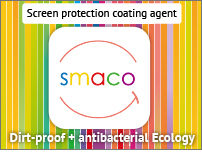
1. Broad antibacterial spectrum
2. Hard to generate resistant strains
3. A nonvolatile agent with long-lasting effect
4. Superior safety
By repeating sterilization and germination, resistant strains will be generated to which the same sterilizing agent won’t work anymore.

Destroys only the outside membranes (mantle) of bacteria and fungi (molds) by a composite synthetic agent containing organic ingredients.
Synthesis of protein, DNA, SH-groups, etc., of bacteria and fungi whose mantles are damaged are inhibited, and thus anti-bacterial effect is exhibited.
Bacteria or fungi whose synthesis are inhibited send warning signals to strains of the same species, so the same species will start avoiding that spot (repelling effect). Also, as they won’t be able to obtain nutrition necessary to grow, they will die eventually.
1. Disturbs the function by damaging only the cell membrane/wall.
2. Elution of minerals from inside the cell (nucleotides, amino acid, protein)
3. Enzyme action is inhibited by blocking synthesis of nucleic acid and protein (random reactions with protein and amino group, phenolic group, SH group, etc. of nucleic acid)
4. Denaturation and coagulation of protein.
5. Reacts with SH in the cell and SH-enzyme and electron transport system are blocked.
6. DNA reproduction is blocked.
7. Mitosis and mycelium elongation are blocked.
8. Breathing is blocked.
9. Lipid synthesis is blocked.
10. Energy transfer is blocked.
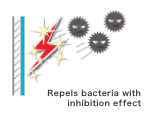
Mold-proof coating agent is effective against 397 types of fungus and bacteria, including these molds.
| Fungus | Alternaria tenuis | Fungus | Alternaria brassicicola | Fungus | Alternaria alternata |
| Fungus | Aspergillus niger | Fungus | Aspergillus flavus | Fungus | Aspergillus versicolor |
| Fungus | Aspergillus oryzae | Fungus | Aspergillus fumigatus | Fungus | Aureobasidium pullulans |
| Fungus | Fusarium moniliforme | Fungus | Fusarium semitectum | Fungus | Fusarium roseum |
| Fungus | Fusarium solani | Fungus | Fusarium oxysporum | Fungus | Rhizopus nigricans |
| Fungus | Rhizopus storonifer | Fungus | Penicillium citrinum | Fungus | Penicillium expansum |
| Fungus | Penicillium funiculosum | Fungus | Penicillium lilacinum | Fungus | Penicillium nigricans |
| Fungus | Penicillium frequentance | Fungus | Penicillium citreoviride | Fungus | Mucor racemosus |
| Fungus | Trichophyton mentagrophytes | Fungus | Nigrospora oryzae | Fungus | Cladosporium resinae |
| Fungus | Cladosporium herbarum | Fungus | Cladosporium caldosporioides | Fungus | Cladosporium sphaerospermum |
| Fungus | Trichoderma koningii | Fungus | Trichoderma T-1 | Fungus | Trichoderma viride |
| Fungus | Phoma glomerala | Fungus | Phoma terrestius | Fungus | Pullularia pullulans |
| Fungus | Geotricham candidum | Fungus | Geotricham lactus | Fungus | Pestalotia adusta |
| Fungus | Pestalotia neglecta | Fungus | Monilia fructigena | Fungus | Chaetomium globosum |
| Fungus | Epicoccum purpurascens | Fungus | Acuremonium charticola | Fungus | Wallemia sebi |
| Fungus | Botrytis cinerea | Fungus | Candida albicans | Bacteria | Saccharomyces cerevisiae |
| Bacteria | Streptoverticillium reticulum | Bacteria | Bacillus subtilis | Bacteria | Bacillus megaterium |
| Bacteria | Staphylococcus aureus | Bacteria | Proteus vulgaris | Bacteria | Pseudomonas aeruginosa |
| Bacteria | Pseudomonas fluorescens | Bacteria | Salmonella typhimurium | Bacteria | Escherichia coli |
| Fungus | Alternaria tenuis | Fungus | Alternaria brassicicola |
| Fungus | Alternaria alternata | Fungus | Aspergillus niger |
| Fungus | Aspergillus flavus | Fungus | Aspergillus versicolor |
| Fungus | Aspergillus oryzae | Fungus | Aspergillus fumigatus |
| Fungus | Aureobasidium pullulans | Fungus | Fusarium moniliforme |
| Fungus | Fusarium semitectum | Fungus | Fusarium roseum |
| Fungus | Fusarium solani | Fungus | Fusarium oxysporum |
| Fungus | Rhizopus nigricans | Fungus | Rhizopus storonifer |
| Fungus | Penicillium citrinum | Fungus | Penicillium expansum |
| Fungus | Penicillium funiculosum | Fungus | Penicillium lilacinum |
| Fungus | Penicillium nigricans | Fungus | Penicillium frequentance |
| Fungus | Penicillium citreoviride | Fungus | Mucor racemosus |
| Fungus | Trichophyton mentagrophytes | Fungus | Nigrospora oryzae |
| Fungus | Cladosporium resinae | Fungus | Cladosporium herbarum |
| Fungus | Cladosporium caldosporioides | Fungus | Cladosporium sphaerospermum |
| Fungus | Trichoderma koningii | Fungus | Trichoderma T-1 |
| Fungus | Trichoderma viride | Fungus | Phoma glomerala |
| Fungus | Phoma terrestius | Fungus | Pullularia pullulans |
| Fungus | Geotricham candidum | Fungus | Geotricham lactus |
| Fungus | Pestalotia adusta | Fungus | Pestalotia neglecta |
| Fungus | Monilia fructigena | Fungus | Chaetomium globosum |
| Fungus | Epicoccum purpurascens | Fungus | Acuremonium charticola |
| Fungus | Wallemia sebi | Fungus | Botrytis cinerea |
| Fungus | Candida albicans | Bacteria | Saccharomyces cerevisiae |
| Bacteria | Streptoverticillium reticulum | Bacteria | Bacillus subtilis |
| Bacteria | Bacillus megaterium | Bacteria | Staphylococcus aureus |
| Bacteria | Proteus vulgaris | Bacteria | Pseudomonas aeruginosa |
| Bacteria | Pseudomonas fluorescens | Bacteria | Salmonella typhimurium |
| Bacteria | Escherichia coli |
Japan Food Research Laboratories
・Dioxin detection test
・Furan detection test
・Acute toxicity test using himedaka (ichthyotoxicity)
・Mutagenicity (AMES) test
・Skin primary irritation test using rabbit
・Acute oral toxicity test using mouse
・Eye irritation test using rabbit
・Fungus resistance test
・O-157 antibacterial test
・MRSA test antibacterial test
・Legionella antibacterial test
Food and Drug Safety Center Hatano Research Institute
・Cytotoxic test using V79 cell
Japan Chemical Innovation and Inspection Institute
・1982 the Ministry of Health and Welfare Notice No. 20 Test
“Resin Plate”
PP Plate/PE Plate/ PET Plate
ABS Plate/PS Plate
“Tableware” PP Tableware
“Film” PP Antibacterial Film / PS Antibacterial Film
| Product type | Solvent | Application |
| Penetration type | Isopropyl alcohol | Concretes, mortar, slates, ALCs, bricks, plasters, stones, and tile joints. |
| Spray type | Water | Humidifiers, aerial spraying, and sprays. |
| Coat type | Water | Painted surfaces, resin. |
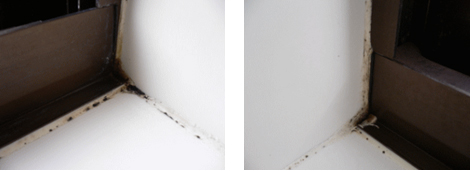
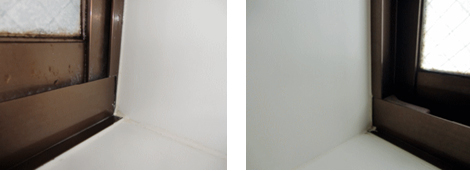
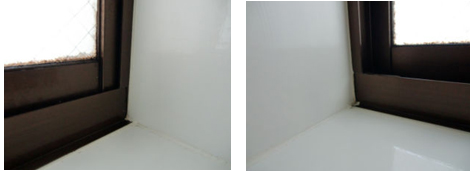
Mold-proof effect lasted for more than 1 year, and molds were easily eliminated and penetration of molds into the sealants was prevented.
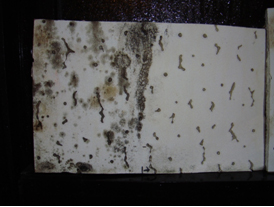
There was no mold growing on the applied surface after more than 2 months.







